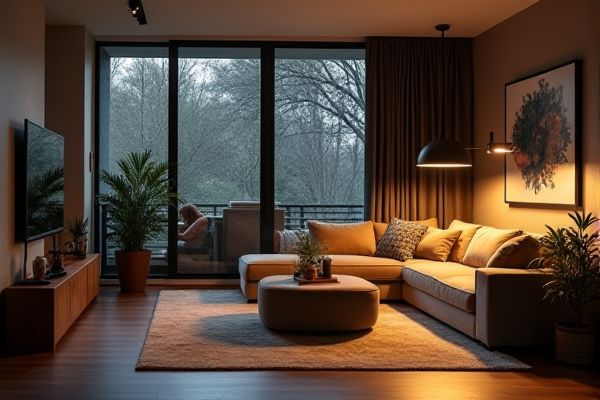
Task lighting focuses on illuminating specific areas where activities like reading or cooking take place, providing concentrated and brighter light; ambient lighting offers a softer, overall illumination that sets the mood and fills the space. Understanding the key differences between task lighting and ambient lighting can help you create a balanced and functional lighting design--explore the rest of the article to discover how to optimize your home lighting.
Table of Comparison
| Feature | Task Lighting | Ambient Lighting |
|---|---|---|
| Purpose | Illuminates specific work areas for activities like reading, cooking, or writing. | Provides overall, general illumination to a room or space. |
| Intensity | Bright, focused light to reduce eye strain and enhance precision. | Softer, diffused light to create a comfortable atmosphere. |
| Placement | Directed precisely on work surfaces or task zones. | Ceiling-mounted fixtures, wall sconces, or lamps that spread light evenly. |
| Examples | Desk lamps, under-cabinet lights, reading lamps. | Chandeliers, recessed ceiling lights, floor lamps. |
| Functionality | Enhances visual clarity for specific tasks. | Creates overall room brightness and mood. |
| Energy Usage | Typically higher per unit area due to focused lighting. | Generally moderate, covering large areas with less intensity. |
Introduction to Task Lighting vs Ambient Lighting
Task lighting provides focused illumination designed to enhance visibility for specific activities such as reading, cooking, or working at a desk, ensuring precision and reducing eye strain. Ambient lighting, also known as general lighting, delivers uniform light throughout a space to create an overall level of brightness and comfortable atmosphere. Understanding the functions and appropriate placement of task lighting versus ambient lighting is essential for effective interior lighting design and energy efficiency.
Defining Task Lighting: Purpose and Features
Task lighting is designed to illuminate specific areas where activities such as reading, cooking, or working require focused, bright light to reduce eye strain and enhance visibility. It typically features adjustable fixtures like desk lamps, under-cabinet lights, or pendant lights, providing concentrated illumination directly on the task area. Your choice of task lighting should prioritize brightness, directionality, and minimal glare to improve efficiency and comfort during detailed tasks.
Understanding Ambient Lighting: Scope and Impact
Ambient lighting provides overall illumination that sets the mood and ensures basic visibility throughout a space, influencing color perception and spatial awareness. Its scope covers uniform light distribution from sources like ceiling fixtures, wall sconces, or natural daylight, essential for creating a comfortable environment and reducing eye strain. Effective ambient lighting balances intensity and color temperature to enhance room aesthetics while supporting visual tasks indirectly.
Key Differences Between Task and Ambient Lighting
Task lighting provides focused, high-intensity illumination designed for specific activities like reading, cooking, or working, enhancing visibility and reducing eye strain. Ambient lighting offers uniform, low-intensity light that creates overall illumination and a comfortable atmosphere in a room. Key differences include intensity, purpose, and placement, with task lighting typically positioned close to the activity area and ambient lighting distributed to fill the entire space.
Advantages of Task Lighting in Various Spaces
Task lighting offers focused illumination that enhances visibility and reduces eye strain in work areas such as kitchens, offices, and craft rooms. It improves productivity by providing bright, directed light exactly where detailed activities like reading, cooking, or typing occur. Unlike ambient lighting, task lighting minimizes shadows and glare, creating a safer and more efficient environment for precision tasks.
Benefits of Ambient Lighting for Room Atmosphere
Ambient lighting creates a balanced and inviting atmosphere by providing soft, diffuse light that reduces harsh shadows and glare. It enhances the overall mood of a room, making spaces feel warm and comfortable while supporting activities without causing eye strain. Well-designed ambient lighting improves spatial perception, contributing to a harmonious and aesthetically pleasing environment.
Best Placement Strategies for Task Lighting
Task lighting is most effective when placed directly above or beside the work area, minimizing shadows and glare to enhance focus and precision. Positioning adjustable lamps or fixtures near desks, kitchen counters, or workbenches ensures targeted illumination tailored to specific activities. Optimal placement includes under-cabinet lights in kitchens and swing-arm lamps in offices, maximizing functionality and visual comfort.
Effective Techniques to Layer Ambient and Task Lighting
Effective techniques to layer ambient and task lighting involve balancing overall illumination with focused light to reduce eye strain and enhance functionality. You can use dimmable overhead fixtures for ambient lighting combined with adjustable desk lamps or under-cabinet lights to create targeted task lighting. Strategically positioning task lights near work areas and selecting fixtures with appropriate color temperature ensures optimal contrast and comfort.
Common Mistakes When Combining Task and Ambient Lighting
Common mistakes when combining task and ambient lighting include inadequate brightness contrast, leading to eye strain and reduced productivity. Overlapping light sources without proper controls can cause glare and uneven illumination, disrupting visual comfort. Selecting incompatible color temperatures between task lights and ambient fixtures often results in an unbalanced, uncomfortable atmosphere.
Choosing the Right Lighting Solution for Your Needs
Task lighting provides focused, bright illumination essential for activities such as reading, cooking, or detailed work, enhancing visibility and reducing eye strain. Ambient lighting offers overall, diffused light to create a comfortable atmosphere and softly illuminate an entire space without harsh shadows. Selecting the right lighting solution depends on activity requirements, room size, and personal preferences to balance functionality and aesthetics effectively.
 homyna.com
homyna.com